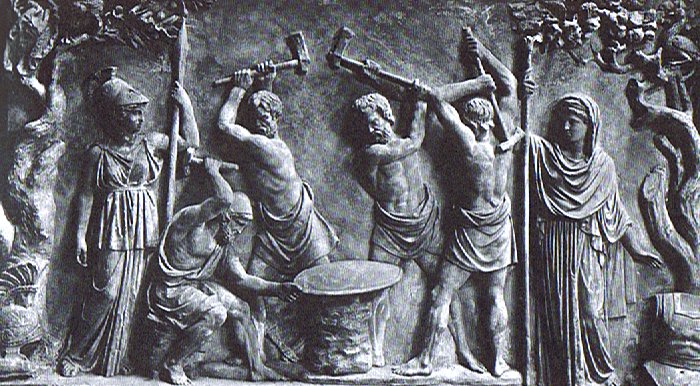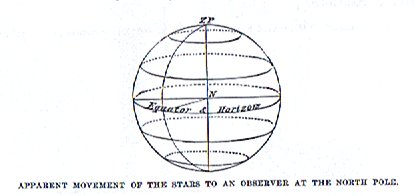... Called the winds to
work the bellows // To the utmost of their
power. // Then the winds arose in fury, //
Blew the east wind, blew the west wind, //
And the south wind yet more strongly, // And
the north winds howled and blustered. Thus
they blew one day, a second, // And upon the
third day likewise. // Fire was flashing
from the windows, // From the doors the
sparks were flying // And the dust arose to
heaven, // With the clouds the smoke was
mingled.
Then again smith
Ilmarinen, // On the evening of the third
day, // Stooped him down, and gazed intently
// To the bottom of the furnace, // And he
saw the Sampo forming, // With its
many-coloured cover.
The main feature of Sampo was evidently its
cover which had many colours. From this we
can deduce the Sun was present, because in
the night only black, white, and shades of
grey, were visible.
Up above the polar circle the Sun was in
principle present during all the 24 hours of
the day during the summer and absent all the 24
hours of the night in winter - although the
declination of the observer would have defined where
summer and winter began.
...
In north Asia the common mode of reckoning
is in half-year, which are not to be
regarded as such but form each one
separately the highest unit of time: our
informants term them 'winter year' and
'summer year'. Among the Tunguses the former
comprises 6½ months, the latter 5, but the
year is said to have 13 months; in Kamchatka
each contains six months, the winter year
beginning in November, the summer year in
May; the Gilyaks on the other hand give five
months to summer and seven to winter. The
Yeneseisk Ostiaks reckon and name only the
seven winter months, and not the summer
months.
This mode of reckoning seems to be a
peculiarity of the far north: the Icelanders
reckoned in misseri, half-years, not
in whole years, and the rune-staves divide
the year into a summer and a winter half,
beginning on April 14 [4-14] and October 14
respectively. But in Germany too, when it
was desired to denote the whole year, the
combined phrase 'winter and summer' was
employed, or else equivalent concrete
expressions such as 'in bareness and in
leaf', 'in straw and in grass' ...
More information follows, and we learn that
this coloured cover had pictures on it:
Thereupon smith Ilmarinen, // He the
great primeval craftsman, // Welded it and
hammered at it, // Heaped his rapid blows
upon it, // Formed with cunning art the
Sampo.
And on one side was a corn-mill, // On
another side a salt-mill, // And upon the
third a coin-mill.
Now was grinding the new Sampo, // And
revolved the pictured cover, // Chestfuls
did it grind till evening, // First for food
it ground a chestful, // And another ground
for barter, // And a third it ground for
storage.
Now rejoiced the Crone of Pohja, // And
conveyed the bulky Sampo, // To the rocky
hills of Pohja, // And within the Mount of
Copper, // And behind nine locks secured it.
There it struck its roots around it, //
Fathoms nine in depth that measured, // One
in Mother Earth deep-rooted, // In the
strand the next was planted, // In the
nearest mount the third one.
Early I spent some time trying to understand
whether
the glyphs Aa1-13--36 described the cycle of
the day or the cycle of the year, but then I
realized that the pattern was the same and
therefore these 24 glyphs could be used for
both purposes. I.e., we could let them
correspond to right ascension hours, for
instance in this way:
|
0h |
1h |
2h |
 |
 |
 |
|
Aa1-13 |
Aa1-14 |
Aa1-15 |
|
kua tuu |
marai |
i tona ohoga - ki
te ariki |
|
3h |
4h |
5h |
6h |
 |
 |
 |
 |
|
Aa1-16 |
Aa1-17 |
Aa1-18 |
Aa1-19 |
|
ka ero |
ka tapamea |
ma te tagata e
hetu noho i te here |
i uhi tapamea |
|
7h |
8h |
9h |
10h |
 |
 |
 |
 |
|
Aa1-20 |
Aa1-21 |
Aa1-22 |
Aa1-23 |
|
e hetuu mau i te
rima kua noho te marama |
e uhi tapamea |
e hetu mata |
e hokohuki |
|
11h |
12h |
13h |
14h |
 |
 |
 |
 |
|
Aa1-24 |
Aa1-25 |
Aa1-26 |
Aa1-27 |
|
ko te nuahine - i
mamau i te ahi |
e uhi tapamea |
ko te ahi -
hakaturou |
ki te henua |
|
15h |
16h |
17h |
18h |
 |
 |
 |
 |
|
Aa1-28 |
Aa1-29 |
Aa1-30 |
Aa1-31 |
|
ka puhi hoki ki te
ahi |
ma te hokohuki |
ki te ahi |
e uhi tapamea |
|
19h |
20h |
21h |
22h |
23h |
 |
 |
 |
 |
 |
|
Aa1-32 |
Aa1-33 |
Aa1-34 |
Aa1-35 |
Aa1-36 |
|
ka puhi hoki
ki te ahi |
ma te toga tu |
te tapamea |
e tagata
hakaganagana |
e uhi tapamea |
The first task of Sampo
was to grind out food - for eating, for
barter, and for storage. If Sampo had 3
pictured sides, then we could try to count 24h /
3 = 8h. The gesture of input
(eating), corresponding to food intake, would then not begin
until Aa1-18 (5h):
Aa1-24, at the last of
these 7 hours - could accordingly
correspond to the end of the mystic
measure of Mother Earth as hard top soil, as a Turtle (Pawahtun)
- and at that time the growth of fire (te ahi) was arrested (mamau),
this Melchior (Metoro
Tau'a Ure)
stated when reading the text for Bishop
Jaussen on Tahiti.
|
Ahi.
Fire; he-tutu
i te ahi to light a fire.
Ahiahi = evening;
ahiahi-ata, the last moments
of light before nightfall.
Vanaga.
1. Candle, stove, fire (vahi);
ahi hakapura, match;
ahi hakagaiei, firebrand
waved as a night signal. P Mgv.:
ahi, fire, flame. Mq.:
ahi, fire, match, percussion
cap. Ta.: ahi, fire,
percussion cap, wick, stove. 2.
To be night; agatahi ahi atu,
day before yesterday. 3. Pau.:
ahi, sandalwood. Ta.:
ahi, id. Mq.: auahi,
a variety of breadfruit. Sa.:
asi, sandalwood. Ha.:
ili-ahi, id. Ahiahi,
afternoon, night; kai ahiahi,
supper. P Pau., Mgv., Mq., Ta.:
ahiahi, afternoon,
evening. Ahipipi (ahi
1 - pipi 2) a spark, to
flash. Churchill. |
... An iconographic study by Jeff
Kowalski suggests a cosmological layout
for the Nunnery. The higher placement of
the North Building, with its 13 exterior
doorways (reflecting the 13 layers of
heaven), and the celestial serpents
surmounting the huts identify it with
the celestial sphere. The iconography of
the West Building, with 7 exterior
doorways (7 is the mystic number of the
earth's surface), and figures of
Pawahtun - the earth god as a turtle
- indicate this to be the
Middleworld, the place of the sun's
descent into the Underworld.
The East Building has mosaic elements
reflecting the old war cult of
Teotihuacan, where tradition had it
that the sun was born; thus, this may
also be Middleworld, the place of the
rising sun. Finally, the South Building
has 9 exterior doorways (the Underworld
or Xibalba had 9 layers), and has
the lowest placement in the compex; it
thus seems to be associated with death
and the nether regions ...

... We should try to count the number of
doorways:
|
→ |
|
7 |
2 * 8 + 1 = 17 |
4 + 1 = 5 |
13 |
|
West |
South |
East |
North |
|
24 |
18 |
|
42 (= 7 * 60) |
My idea here of a pattern
in the design of the 'Nunnery', with 24
followed by 18, could have been
influenced by the pattern of the glyphs
following Aa1-36, which sequence appears to
be emerging from the 'ashes' (ehu)
of the 'fire':
 |
 |
 |
 |
 |
 |
 |
|
Aa1-37 |
Aa1-38 |
Aa1-39 |
Aa1-40 |
Aa1-41 |
Aa1-42 |
Aa1-43 |
|
e ia toa tauuru -
ehu |
e ia toa tauuru -
ehu |
e ia toa tauuru -
no te uru nuku |
e ia toa tauuru |
e tauru papagete |
e ia toa
tauuruuru raaraa |
|
... And the dust arose to
heaven, // With the clouds the
smoke was mingled.
|
Ehu
(cfr kehu and
nehu). Ehu ûa,
drizzle. Vanaga.
Firebrand. Ehuehu:
1. Ashes. P Mgv.: ehu,
ashes, dust; rehu,
a cinder, ashes. Mq.:
ehuahi, ashes. Ta.:
rehu, ashes,
soot, any powder. 2.
Brown, brownish. P Ta.:
ehuehu, red,
reddish. Ha.: kehu,
red or sandy haired.
Mq.: kehu, fair,
blond. Mgv.:
keukeu-kura, id.
Ma.: kehu,
reddish brown. Sa.:
'efu, id. To.:
kefu, yellowish.
Fu.: kefu, blond,
red. Niuē:
kefu,
a disrespectful term of
address. Ragi
ehuehu,
a cloudflecked sky. 3.
Imperceptible.
Churchill.
Pau.: kehu,
flaxen-haired, blond.
Ta.:
ehu,
reddish. Mq.:
kehu,
blond. Sa.:
'efu,
reddish, brown. Mq.:
kehukehu,
twilight. Ha.:
ehuehu,
darkness arising from
dust, fog, or vapor.
Churchill. |
|
| |
dust |
ashes |
vapor |
darkness |
twilight |
muddy |
|
Samoa |
efu |
lefu |
|
nefu |
|
nefu |
|
Tonga |
efu |
efu |
|
nefu |
nefu |
ehu |
|
Niuē |
efu |
efu |
lefu |
|
|
|
|
Uvea |
efu, nefu |
efu, lefu |
nefu |
nefu |
|
nefu |
|
Futuna |
efu |
lefu |
|
nefu |
|
|
|
Nukuoro |
rehu |
lefu |
|
|
|
|
|
Maori |
nehu |
rehu |
ehu, nehu,
rehu |
rehu, nehu |
|
ehu |
|
Moriori |
|
rehu |
|
|
|
|
|
Tahiti |
rehu |
rehu |
|
|
rehu |
ehu |
|
Marquesas |
ehu |
ehu |
|
|
ehu |
|
|
Rarotonga |
|
reu |
|
reu |
|
|
|
Mangareva |
ehu, neu |
ehu, rehu |
|
|
|
|
|
Hawaii |
ehu |
lehu |
ehu |
ehu, lehu |
|
|
 |
 |
 |
 |
 |
|
Aa1-44 |
Aa1-45 |
Aa1-46 |
Aa1-47 |
Aa1-48 |
|
e ia
toa tauuru |
i te fenua - e
ia toa tauuru
- ma te hokohuki - e ika no te
tagata |
ma te
tauuru
ki te
ragi |
e
tauuru
no te henua |
 |
 |
 |
 |
 |
 |
|
Aa1-49 |
Aa1-50 |
Aa1-51 |
Aa1-52 |
Aa1-53 |
Aa1-54 |
|
e
ihe
ka pipiri i te henua |
ma te
Rei |
mata |
te ua roa |
Twice 4 = 8 and 18 = 2 +
16, i.e. maybe we should count 2 glyphs
per unit of time - which would be in
harmony with how the Moon in the night
had 2 faces, growing and declining, and
how there were 2 weeks in a fortnight,
a pair of fortnights in a month, and 2 * 29½ =
59 nights in a synodic lunar
double-month. And a pair of half-years
in a year.
This idea will then lead
to a reconsidering of the meaning of the preceding 24
glyphs (Aa1-13--36). On Easter Island
the Moon probably ruled the primary measures of
time, and therefore the daytime could
have been counted as 24 / 2 = 12 periods,
corresponding to the number for
half-months in a half-year. Indeed this
could be supported by the basic design of
the structure:
|
0 |
 |
 |
 |
|
Aa1-13 |
Aa1-14 |
Aa1-15 |
|
kua tuu |
marai |
i tona ohoga - ki
te ariki |
|
1 |
2 |
 |
 |
 |
 |
|
Aa1-16 |
Aa1-17 |
Aa1-18 |
Aa1-19 |
|
ka ero |
ka tapamea |
ma te tagata e
hetu noho i te here |
i uhi tapamea |
|
Hiero.
To shine,
to appear (of the rays of
the sun just before
sunrise). He hiero te
raá, dawn breaks.
Vanaga. |
|
Uero. Comet, star,
twilight, a ray, to be
radiant (huero).
Huero veravera, burning
ray. Hueroero, a ray.
Pau.: tuverovero,
comet. Mgv.: etuvero,
id. Churchill. |
|
Vaero.
Chicken's
long tail feather; lobster's
antenna (vaero ura).
Vanaga. Tail of a kite, tail
of a bird (uero). T
Pau.: tuavaero, rump;
kaero, tail. Mgv.:
vero, tail. Mq.: veó,
id. Ta.: aero, id.
Churchill. |
|
Hero.
Herohero.
1. Crimson,
bright
red; he varu i te ki'ea ka herohero ró te hakari, to paint one's
body red with ki'ea;
ku hú á te huka-huka, ku
herohero á i roto i te ahi,
burning wood shows red in
the fire. 2. The colour of
ripe fruit, the
yellow of ripe bananas. 3.
Figuratively: angry:
ku herohero á te manava =
ku ká te manava. Vanaga.
Herohero.
Scarlet,
suffocating T. Ura
herohero, brilliance of
flames. Churchill.
(58) ata
popohanga toou e to ata hero
e, 'Yours is the morning
shadow' refers to an area in
Ata Hero where the
house of Ricardo Hito is now
located. Barthel 2. |
|
|
3 |
4 |
 |
 |
 |
 |
|
Aa1-20 |
Aa1-21 |
Aa1-22 |
Aa1-23 |
|
e hetuu mau i te
rima kua noho te marama |
e uhi tapamea |
e hetu mata |
e hokohuki |
|
Hoko.
1. To
jump; to rock or
swing in rhythm with the
chants in festivals, as was
the ancient custom; an
ancient
dance. He to'o mai e te hoa manu i te mamari ki toona rima, he ma'u,
he hoko, the 'bird
master' receives the egg in
his hand and carries it,
dancing. 2. Number prefix:
'in a group of...':
hokotahi,
alone; hokorua, in a group of two (also companion, e
hakarere te kai mo toou
hokorua, leave some food
for my companion);
hakatoru, in a group of
three, etc.; hokohía,
in a group of how many?
Hokohía ana oho koe ki te
rano? With how many
people will you go to the
volcano? Vanaga.
1. To
traffic, to trade, to buy,
to ransom (hoò);
hoòa te kaiga, to buy
land. 2. To sport, to play.
Churchill. Move the body to
and fro with the rythm of a
song. Barthel. |
|
Huki.
1. Pole
attached to the poop from
which the fishing-net
is suspended: huki kupega.
2.
Digging stick. 3. To
set vertically, to
stand (vt.). 4. Huki á te
mahina, said of the new
moon when both its horns
have become visible. Vanaga.
1. To post up, to publish.
2. To cut the throat (uki).
Mq.: Small sticks which
close up the ridge of a
house. Ha.: hui, the
small uniting sticks in a
thatched house. Churchill.
Standing upright. Barthel.
M. Spit for roasting. Te
Huki, a constellation.
Makemson.
Hukihuki. 1. Colic. 2.
To transpierce, a pricking.
3. To sink to the bottom.
Churchill. |
|
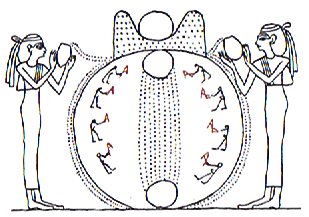
This Egyptian picture
seems to illustrate a division into a
pair of halves, beyond the point where
the Sun emerged, and these halves carry 4
henen signs each. Possibly we
should count 4 * 29½ * 2 = 118 + 118 =
236 nights as a fundamental measure of time. The G
tablet has twice as many nights, given
that each glyph was corresponding to a
night and given that night number zero
was not written down.

|
1
(5) |
2
(6) |
 |
 |
 |
 |
|
Aa1-24 |
Aa1-25 |
Aa1-26 |
Aa1-27 |
|
ko te nuahine -
i
mamau i te ahi |
e uhi tapamea |
ko te ahi -
hakaturou |
ki te henua |
|
3
(7) |
4 |
 |
 |
 |
 |
|
Aa1-28 |
Aa1-29 |
Aa1-30 |
Aa1-31 |
|
ka puhi hoki ki te
ahi |
ma te hokohuki |
ki te ahi |
e uhi tapamea |
Metoro evidently tried
very hard to convey the meaning of the
rongorongo texts and we have to
carefully look at each Sign he gave.
Here we should notice that he at Aa1-32
used exactly the same expression as at
Aa1-28, which possibly meant glyph pair
number 4 + 3 = 7 coincided with glyph
pair 4 + 5 = 9:
 |
 |
 |
 |
 |
|
Aa1-32 |
Aa1-33 |
Aa1-34 |
Aa1-35 |
Aa1-36 |
|
ka puhi hoki
ki te ahi |
ma te toga tu |
te tapamea |
e tagata
hakaganagana |
e uhi tapamea |
|
Puhi.
1. To
blow; to light a fire;
to extinguish, to blow
out; he-puhi te umu,
to light the fire
for the earth oven. 2.
To fish for lobsters at
night using a bait (but
during the day one calls
it hî); puhiga,
night fishing spot.
Vanaga. To blow; puhi
mai, to spring up;
pupuhi, wind,
fan, to blow, puffed up,
to blow fresh, to
ferment, to swell, to
bloat, to spring out, to
gush, yeast; pupuhi
vai, syringe;
pupuhi eve, squirt;
pupuhi heenua,
volley; pupuhi nunui,
cannon; pupuhi nui,
swivel gun; ahuahu
pupuhi, amplitude;
vai pupuhi, water
which gushes forth;
pupuhihia, to carry
on the wind;
hakapupuhi, to gush,
leaven, volatilize;
puhipuhi, to smoke,
to smoke tobacco, a
pipe. Churchill.
 |
...
And the dust arose to heaven, //
With the clouds the smoke was
mingled. |
 |
 |
 |
 |
 |
|
Aa1-37 |
Aa1-38 |
Aa1-39 |
Aa1-40 |
Aa1-41 |
|
e ia toa tauuru -
ehu |
e ia toa tauuru -
ehu |
e ia toa tauuru -
no te uru nuku |
e ia toa tauuru |
e tauru papagete |
 |
 |
 |
 |
|
Aa1-42 |
Aa1-43 |
Aa1-44 |
Aa1-45 |
|
e ia toa
tauuruuru raaraa |
e ia
toa tauuru |
i te fenua |
 |
 |
 |
|
Aa1-46 |
Aa1-47 |
Aa1-48 |
|
e ia toa tauuru - ma te hokohuki
- e ika no te tagata |
ma te
tauuru
ki te
ragi |
e
tauuru
no te henua |
 |
 |
 |
|
Aa1-49 |
Aa1-50 |
Aa1-51 |
|
e
ihe
ka pipiri i te henua |
 |
 |
 |
|
Aa1-52 |
Aa1-53 |
Aa1-54 |
|
ma te
Rei |
mata |
te ua roa |
In the C text, we have
seen, Metoro said e niu tu (not
kua tuu) at
Kochab (β
Ursae Minoris), which was the
Pole Star at the time when Bharani and
Zuben Elgenubi had marked 0h respectively
day *183:
 |
 |
|
kua tuu |
e niu tu |
|
Tu.
To crush into
puree, like women of old did,
crushing sweet potatoes and
mixing them with cooked egg to
give the children. Vanaga. To
mix, to confound. Churchill. |
|
Tuu.
1. To stand erect. 2. Mast,
pillar, post. Van Tilburg. 1. To
stand erect, mast, pillar, post;
tuu noa, perpendicular;
tanu ki te tuu, to set a
post; hakatu tuu, to step
a mast; tuu hakamate tagata,
gallows; hakatuu, to
erect, to establish, to
inactivate, to form, immobile,
to set up, to raise. P Mgv.,
Mq., Ta.: tu, to stand
up. 2. To exist, to be. Mgv.:
tu, life, being, existence.
3. To accost, to hail; tuu
mai te vaka, to hail the
canoe. Mgv.: tu, a cry, a
shout. 4. To rejoin; tuua
to be reunited. 5. Hakatuu,
example, mode, fashion, model,
method, measure, to number. PS
Sa.: tu, custom, habit.
Fu.: tuu, to follow the
example of. 6. Hakatuu,
to disapprove; hakatuu riri,
to conciliate, to appease wrath.
7. Hakatuu, to presage,
prognostic, test. 8. Hakatuu,
to taste. 9. Hakatuu, to
mark, index, emblem, seal, sign,
symbol, trace, vestige, aim;
hakatuu ta, signature;
akatuu, symptom; hakatuua,
spot, mark; hakatuhaga,
mark; hakatuutuu,
demarcation. Churchill.
1. To arrive:
tu'u-mai. 2. Upright pole;
to stand upright (also:
tutu'u). 3. To guess
correctly, to work out (the
meaning of a word) correctly:
ku-tu'u-á koe ki te vânaga,
you have guessed correctly [the
meaning of] the word. 4. To hit
the mark, to connect (a blow).
5. Ku-tu'u pehé, is
considered as... ; te poki
to'o i te me'e hakarere i roto i
te hare, ku-tu'u-á pehé poki
ra'ura'u, a child who takes
things that have been left in
the house is considered as a
petty thief. Tu'u aro,
northwest and west side of the
island. Tu'u haígoígo,
back tattoo. Tu'u haviki,
easily angered person.Tu'u-toga,
eel-fishing using a line
weighted with stones and a hook
with bait, so that the line
reaches vertically straight to
the bottom of the sea.
Tu'utu'u, to hit the mark
time and again. Tu'utu'u îka,
fish fin (except the tail fin,
called hiku). Vanaga.
... To the
Polynesian and to the Melanesian
has come no concept of bare
existence; he sees no need to
say of himself 'I am', always 'I
am doing', 'I am suffering'. It
is hard for the stranger of
alien culture to relinquish his
nude idea of existence and to
adopt the island idea; it is far
more difficult to acquire the
feeling of the language and to
accomplish elegance in the
diction under these unfamiliar
conditions. Take for an
illustrative example these two
sentences from the Viti: Sa
tiko na tamata e kila: there
are (sit) men who know. Sa tu
mai vale na yau: the goods
are (stand) in the house. The
use of tu for tiko
and of tiko for tu
would not produce
incomprehensibility, but it
would entail a loss of finish in
diction, it would stamp the
speaker as vulgar, as a white
man ... Savage life is far too
complex; it is only in rich
civilization that we can rise to
the simplicity of elemental
concepts ... Churchill 2. |
 |
 |
 |
 |
|
Cb1-12 (354 + 50) |
Cb1-13 |
Cb1-14 (350 + 8 * 7) |
Cb1-15 (407) |
|
manu rere -
kua rere ga manu
- ki te ragi |
eaha te nuku erua |
koia kua huki |
e niu tu |
|
Ga.
Preposed
plural marker of rare usage.
1. Sometimes used with a few
nouns denoting human beings,
more often omitted. Te ga
vî'e, te ga poki, the
women and the children.
Ga rauhiva twins. 2.
Used with some proper names.
Ga Vaka, Alpha and
Beta Centauri (lit. Canoes).
Vanaga.
Significantly this is the
only place among the
readings of Metoro where he
used the binome rere ga.
Beta Centauri (Agena, the
Knee) rose together with
Thuban and this was 9 (=
*221 - *212) days earlier
than Toliman at the Janus
type of hau tea in
Cb1-3 when at the other side
of the sky was the Knot
(Alrisha). |
|
INVISIBLY CLOSE TO THE SUN
(helical dates): |
|
ρ Lupi (221.0),
TOLIMAN
(Shoot of the Grapevine) = α
Centauri
(221.2), π Bootis (221.8), ζ
Bootis (221.9) |
31 Bootis (222.0),
YANG MUN
(South Gate) = α Lupi
(222.1),
RIJL AL AWWA (Foot of the
Barker) = μ Virginis
(222.5), ο Bootis (222.9) |
IZAR (Girdle) = ε Bootis
(223.0),
109 Virginis,
α
Apodis (No Feet)
(223.3), μ Librae (223.8) |
Al Zubānā-14a
(Claws) /
Visakha-16 (Forked) /
Root-3 (Badger)
ZUBEN ELGENUBI
(Southern
Claw)
= α Librae
(224.2), ξ Bootis, ο Lupi
(224.5) |
KOCHAB
(Kakkab,
the Star) = β Ursae Min.
(225.0), ξ Librae (225.7) |
|
Oct 28 (301) |
29 |
30 (366 - 63) |
31 (304 = 80 + *225) |
Nov 1 |
|
ºOct 24 |
25 |
26 |
27 (300) |
28 |
|
'Oct 1 |
2 |
3 |
4 (277) |
5 |
|
17 (260) |
(*222 - *41) |
"Sept 19 (*182) |
20 |
21 (264) |
|
AUG 25 |
26 (*222 - *64) |
27 (239 = 303 - 64) |
28 (60 + 180) |
29 (241 = 58 + 183) |
|
217 - 218 |
219 |
220 (= 240 - 20) |
221 (= 225 - 4) |
 |
|
CLOSE TO THE FULL MOON (and
nakshatra dates): |
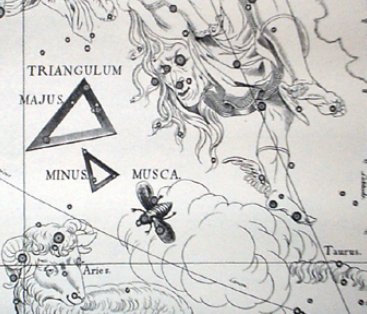 |
|
ν Arietis (38.5), δ, ε Ceti
(38.8) |
μ Arietis (39.4),
HEAD OF THE FLY
= 35 Arietis
(39.6),
KAFFALJIDHMA (Part of a
Hand) = γ Ceti,
θ Persei (39.8) |
π Ceti, ο Arietis (40.0),
ANGETENAR (Bend in the
River) = τ¹ Eridani,
μ Ceti (40.2),
RIGHT WING
= 39 Arietis
(40.9) |
Bharani-2 (Yoni) /
Stomach-17 (Pheasant)
π Arietis (41.2),
MIRAM (Next to the Pleiades)
= η Persei
(41.3),
BHARANI
= 41 Arietis (41.4),
τ² Eridani, σ Arietis (41.7) |
TA LING (Great Mound)
= τ Persei (42.4) |

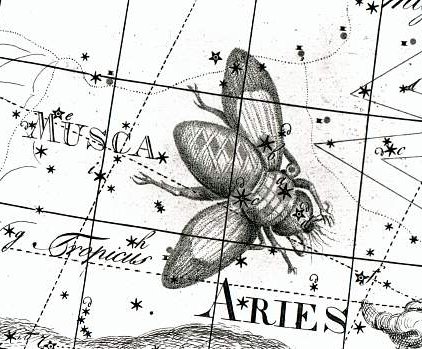 |
|
28 (118) |
(4 * 29½ + 1) |
April 30 |
May 1 (121) |
2 |
|
24 |
25 |
ºApril 26 |
27 |
28 (118) |
|
'April 1 (91) |
2 (7 * 13 + 1) |
3 |
4 (*14 = *41 - *27) |
5 |
|
"March 18 |
19 (*364) |
3-20 (*365) |
0h (*366) |
"March 22 (*1) |
|
FEBR 23 |
BIS-SEXTUM |
25 (56 = 120 - 64) |
26 (*343 = *366 - 23) |
2-27 |
|
34 - 35 |
36 = 56 - 20 |
37 = 41 - 4 |
38 = 58 - 20 |
|
399 - 400 |
401 (= 36 + 365) |
402 (= 220 + 182) |
403 = 407 - 4 |
|
The sequence of heliacal
star dates in the text seems
here to make a jump ahead
with 1 place, because *366 =
365 + 1 and from Arcturus,
Syrma (*215) to Zuben
Elgenubi (*224) there were
not 9 but 8 glyphs. Likewise
were there 9 precessional
days from *32 to *41
(Bharani).
The sky dome was moving said
Metoro where the Full Moon
reached Mira.
Maeva.
T.
1. Move. Rangi-maeva
= Moving Sky (name of a
marae). 2. Greet, greeting.
Henry. |
|
...
The leap day
was introduced as part of
the Julian reform. The day
following the Terminalia
(February 23) was doubled,
forming the 'bis sextum
- literally 'double sixth',
since February 24 was 'the
sixth day before the Kalends
of March' using Roman
inclusive counting (March 1
was the 'first day').
Although exceptions exist,
the first day of the bis
sextum (February 24) was
usually regarded as the
intercalated or 'bissextile'
day since the third century.
February 29 came to be
regarded as the leap day
when the Roman system of
numbering days was replaced
by sequential numbering in
the late Middle Ages ...
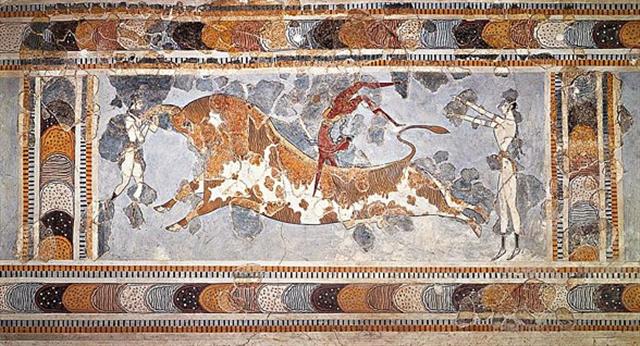 |
As to the expression
te ua roa (the great rain), which
came 54 - 13 = 41 glyphs later than
kua tuu, we should notice that Metoro
when reading
the C tablet used another but similar expression
ka hua roa at the heliacal Pleiades
(which at the time of rongorongo rose
heliacally in May 16):
|
196 |
 |
 |
 |
 |
 |
 |
|
Cb9-12 (604) |
Cb9-13 |
Cb9-14 (214) |
Cb9-15 |
Cb9-16 |
Cb9-17 |
|
te maitaki -
ka hua roa |
te maitaki -
oho te vae |
te inoino |
oho te vae |
e inoino |
oho te vae |
|
Hua.
1.
Testicle. 2.
Figuratively: son,
hua tahi, only son;
fruits of the earth; to
grow well (of fruits).
3. To cause a fight, a
quarrel. Hua-ai,
generation, as
lineage of direct
descendents;
contemporaries. Huahua, coccyx of bird, 'parson's nose':
huahua moa,
huahua uha.
Huataru, a
creeper (Chenopodium
ambiguum). Vanaga.
1. The
same; ki hua,
again, to continue, to
strain, to struggle, to
move, to repeat, over
and above. Mq.: hua,
the same, to return, to
recommence. 2. To
bloom, to sprout;
flower, fruit (huaa);
huaa tae oko,
huaa vahio, young
fruit; hua atahi,
only son; huahaga,
fruit; mei te huahaga
o tokoe kopu, the
fruit of thy body;
tikea huahaga,
deceptive appearance. P
Pau.: ua, to be
born; huahaga,
lineage. Mgv.: hua,
to produce (said of
trees, grain, etc.),
blooming time of
flowers, abundance of
fruit. Mq.: hua,
to produce, to bear
fruit. Ta.: ua,
to sprout. Huahua.
1. Tailless fowl. 2.
Vein, tendon, line. 3.
Mgv.: huahua,
pimples covering the
face. Ta.: huahua,
id. Mq.: hua,
tubercules. Sa.:
fuafua, abscess on
hand or feet. Ma.:
huahua, small
pimples. Pau.:
Hua-gakau, rupture.
Ta.: áau,
entrails. Sa.: ga'au,
id. Ma.: ngakau,
id. Churchill. 1. Fruit.
2. Egg. 3. Tā
hua = 'genealogical
writing' or 'same
writing'. Fischer. |
|
|
Time frame of Bharani: |
|
*184 + *197 - *366 = *15 |
*16 |
*17 |
*18 |
*19 |
*20 |
|
"April 5 |
6 |
7 |
8 |
9 |
10 (100) |
|
*1 + *197 = *198 = *15 + *183 |
*199 |
*200 |
*201 |
*202 |
*203 |
|
"Oct 7 |
8 |
9 (280) |
10 |
11 |
12 |
|
Time frame of rongorongo: |
|
*15 + *41 = *56 |
*57 |
*58 |
*59 |
*60 |
*61 |
|
May 16 (136) |
17 |
18 |
19 |
20 |
21 |
|
*198 + * 41 = *239 |
*240 |
*241 |
*242 |
*243 |
*244 |
|
Nov 15 |
16 (320) |
(280 + 41) |
18 |
19 |
20 |
The normal word of Metoro at
the type of glyph in Aa1-54 was vae
and obviously a leg with a pronounced knee
was depicted:
|
Vae.
Va'e: Foot, leg; te va'e
mata'u, te va'e maúi, right
foot, left foot. Va'e ruga, va'e
raro, quick and light, without
detour (lit.: foot up, foot down).
Ka-oho koe ki a nua era va'e ruga
va'e raro, ina ekó hipa-hipa,
hurry straight to your mother, do
not make any detours. Va'e pau,
misshapen foot, clubfoot. Vae,
to choose. Vaega, middle,
centre; i vaega o, in the
middle of. Vanaga. 1. Foot, paw,
leg, limb; vae no roto,
drawers; karikari vae, ankle.
P Pau.: vaevae, foot, leg.
Mgv.: vaevae, id. Mq.: vae,
id. Ta.: vaevae, avae,
id. 2. Pupil. 3. To choose, elect,
prefer, promote, vote; vavae,
to destine, to choose; vaea (vae
2), pupil. Vaeahatu (vae
1 - ahatu): moe vaeahatu,
to sleep sprawling with legs
extended. Vaega, center,
middle, within, half; o vaega,
younger; ki vaega, among,
between, intermediate. P Pau.:
vaega, the middle. Mgv.:
vaega, center, middle. Mq.:
vaena, vavena, vaveha,
id. Ta.: vaehaa, half.
Vaehakaroa (vae 1 -
roa): moe vaehakaroa, to
sleep with legs stretched out.
Vaehau (vae 1 - hau
3), pantaloons, trousers.
Vaeherehere (vae 1 -
here 1), to attach by the paw.
Vaerere (vae 1 -
rere 1), to run. Churchill. Ta.:
1. Timbers of a boat. Ha.: wae,
knees, side timbers of a boat. 2. To
share out. Sa.: vae, to
divide, to share. Ma.: wawae,
to divide. Churchill. |
 |
 |
|
vae |
te ua roa |
On the other hand we have the
Chinese Wolf station - closely
connected with legs (walking) and presumably also with
the seed funnel in Draco (...
The
Plough,
Most of Draco. The
Wolf
at the seed funnel of the Plough, Head &
middle of Draco ...). This was
where the left armpit of Andromeda
nourished the back side of the rising
fish:
... To
endow it with power she placed it under her
arm, lay down and slept for three days ...

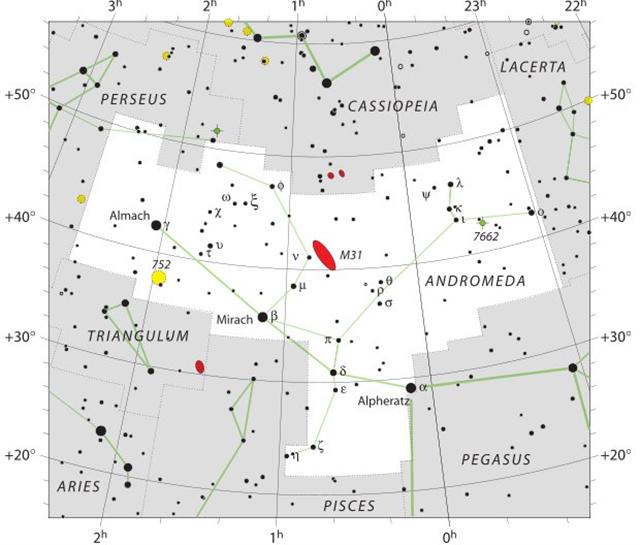
 |
 |
 |
 |
 |
 |
|
*Ca14-12 |
→ 14 * 13 = 182 |
→ 4.14 |
(378 → Saturn) |
→ 14 * 16 = 224 |
*Ca14-17 |
|
te
kihikihi |
o te henua
- kua haga hia |
kua pua |
te vero |
te henua |
kiore - te
henua |
|
CLOSE TO THE FULL MOON (and
nakshatra dates): |
|
ξ
Phoenicis (9.0),
ρ
Tucanae (9.1),
DENEB KAITOS (Tail of the
Sea Beast) =
β
Ceti,
η
Phoenicis (9.4),
AL NITHĀM (String of Pearls)
=
φ¹
Ceti
(9.6) |
ACHIRD (Woman with Luminous
Rays) =
η
Cassiopeiae
(10.7) |
Legs-15 (Wolf)
ν
Andromedae (11.0),
φ²
Ceti (11.1),
ρ
Phoenicis (11.2),
η
Andromedae
(11.4) |
CIH
(Whip) =
γ
Cassiopeiae,
λ
Tucanae (12.4),
φ³
Ceti (12.6),
μ
Andromedae (12.8) |
φ4 Ceti (13.2) |
no star listed (14) |
|
... At the beginning of 44
B.C. - when Ceasar was still
alive - the Senate decided
to raise statues of him in
all the temples and to
sacrifice to him on his
birthday in the month
Quintilis, which in
honour of him was renamed
July. He was raised to the
status of a god (among the
other gods of the state)
under the name Jupiter
Julius. Marcus Antonius, who
this year was consul
together with Ceasar, became
high priest and responsible
for the ceremonies. In the
middle of February, at the
time of the old feast of
Lupercalia [cfr Lupus
= Wolf], he ran around naked
and whipped the Roman ladies
with thongs made from
goat-skin [februa],
in order to promote their
fertility ... |
|
March 30 |
31 (455) |
April 1 (91) |
2 |
3 |
4 |
|
'March 3 (427) |
(2 * 214) |
5 (8 * 8 = 91 - 27) |
6 |
7 (2 * 31 + 4) |
8 (6 * 72) |
|
366 |
367 |
365 + 3 |
369 |
740 / 2 |
371 |
|
INVISIBLY CLOSE TO THE SUN
(helical dates): |
|
Sept 29 |
30 (273 = 3 * 91) |
Oct 1 |
2 |
3 |
4 |
|
ι Crucis (192.2), β Muscae
(192.5),
MIMOSA = β Crucis
(192.9) |
no star listed (193) |
κ Crucis (194.4), ψ Virginis
(194.5), μ Crucis, λ Crucis
(194.6),
ALIOTH (Fat Tail) = ε Ursae
Majoris,
ι Oct. (194.8) |
MINELAUVA = δ Virginis
(195.1),
COR CAROLI
= α Canum Ven.
(195.3) |
δ Muscae (196.5),
VINDEMIATRIX (Grape
Gatherer) = ε Virginis
(196.8) |
13h (197.8)
ξ¹ Centauri (197.1), ξ²
Centauri (197.9) |
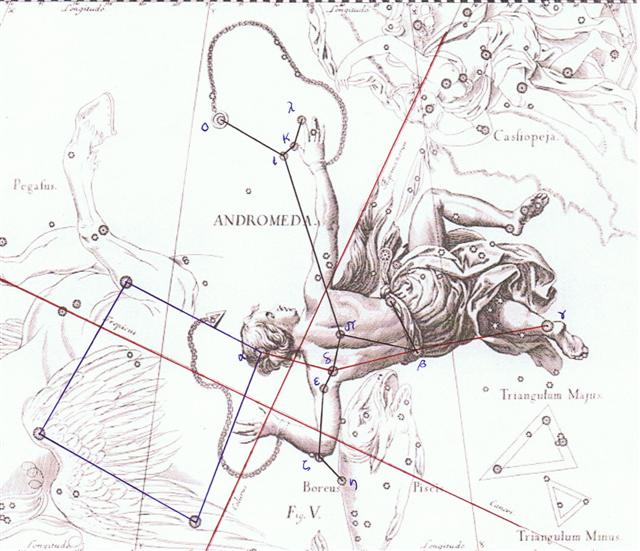
|
